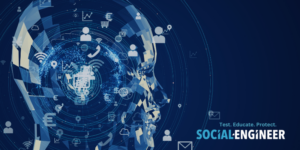In the ever-evolving landscape of cybersecurity, social engineering has undergone significant transformations over the years, propelled by advancements in technology. From traditional methods to the integration of artificial intelligence (AI), malicious actors continually adapt and leverage emerging tools to exploit vulnerabilities. This article delves into the historical shifts in social engineering tactics and explores how adversaries embrace new technologies to achieve their objectives.

Historical Shifts:
Social engineering has a rich history that reflects the evolution of technology from the pre-internet era to the rise of social media. Understanding these historical shifts provides valuable insights into the evolving nature of social engineering.
Pre-Internet Era:
In the pre-internet era, social engineering primarily relied on interpersonal communication and physical access. Techniques included impersonation, dumpster diving for sensitive information, and manipulating individuals through phone calls (also known as vishing). Malicious actors exploited trust and human psychology to gain unauthorized access. Many of these tactics would still be used as time went on.
Phishing and the Internet Boom:
With the rise of the internet, phishing became a prevalent social engineering tactic. Attackers utilized emails to deceive individuals into revealing sensitive information. As technology advanced, phishing techniques evolved to include more sophisticated email designs and persuasive content. As seen in the modern day, phishing is still a viable option for malicious actors. At times, attackers have even combined the likes of phishing and vishing for a hybrid attack.
Social Media Exploitation:
The widespread adoption of social media platforms opened new avenues for social engineering attacks. Malicious actors leveraged personal information shared on social media to craft targeted attacks. Spear phishing emerged as a more refined technique; tailoring messages based on detailed knowledge about the target. In effect, social media allowed many attackers to build a more thorough profile of their target.
Adapting to AI:
Social engineering continues to evolve with the integration of AI, presenting new challenges for corporations. Automation and AI-assisted attacks have become prevalent, and the emergence of deepfake technology poses unique threats. Organizations must adapt their defenses to counter these advanced tactics.
Automation and AI-Assisted Attacks:
Malicious actors have embraced AI to automate and enhance social engineering attacks. AI algorithms analyze vast datasets to craft convincing phishing messages and simulate human-like communication. This level of sophistication poses new challenges for traditional defense mechanisms.
Deepfake Technology:
The advent of deepfake technology allows attackers to impersonate individuals convincingly. Malicious actors can create realistic audio and video content, making it challenging to distinguish between genuine and manipulated communication. This poses a serious threat to organizations relying on voice and video for authentication.
Exploiting Chatbots and Virtual Assistants:
AI-driven chatbots and virtual assistants are exploited to impersonate trusted figures within organizations. Attackers use these tools to deceive employees into disclosing sensitive information, highlighting the need for heightened awareness and identity verification.
Adapting Corporate Defenses:
To effectively counter the evolving landscape of social engineering, corporations must implement adaptive defense strategies. Continuous employee training, simulated testing, integration of advanced AI security solutions, and regular security audits are crucial components of a comprehensive cybersecurity posture.
Continuous Employee Training:
Corporations must evolve their training programs to address the changing tactics of social engineering. Employees need to be educated on recognizing AI-driven attacks, deepfakes, and other emerging threats. They should be tested to ensure the training they have received is effective and on top of this, educated in the proper reporting procedures. Reporting is essential, as at times employees may find themselves as the first line of defense against attackers. Teaching them to always be on guard will help build that security-minded culture in a company.
Integration of Advanced AI Security Solutions:
To counter AI-powered social engineering, many organizations have invested in advanced AI security solutions. These systems can analyze patterns, detect anomalies, and provide real-time threat intelligence, enhancing the ability to respond effectively. This not only helps protect against external attacks, but even the likes of insider threats.
Regular Security Audits and Updates:
Routine security audits are crucial to identifying and patching technical vulnerabilities. Organizations should stay vigilant, keeping software, applications, and security measures up to date to withstand evolving threat actor techniques. A detailed security response procedure should be in place in the event an attack is successful, as this will help prevent further damage and neutralize the threat.
Conclusion:
As technology continues to advance, social engineering tactics will inevitably evolve. Artificial Intelligence is no longer something from science fiction movies. Understanding the historical shifts in social engineering and staying ahead of emerging threats is crucial for corporations. By fostering a culture of cybersecurity awareness, leveraging advanced technologies, and adapting defensive strategies, organizations can fortify themselves against the ever-changing landscape of social engineering threats.
Written by:
Josten Peña
Human Risk Analyst at Social-Engineer, LLC

